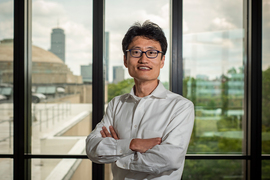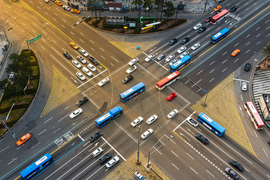Cathy Wu has always delighted in systems that run smoothly. In high school, she designed a project to optimize the best route for getting to class on time. Her research interests and career track are evidence of a propensity for organizing and optimizing, coupled with a strong sense of responsibility to contribute to society instilled by her parents at a young age.
As an undergraduate at MIT, Wu explored domains like agriculture, energy, and education, eventually homing in on transportation. “Transportation touches each of our lives,” she says. “Every day, we experience the inefficiencies and safety issues as well as the environmental harms associated with our transportation systems. I believe we can and should do better.”
But doing so is complicated. Consider the long-standing issue of traffic systems control. Wu explains that it is not one problem, but more accurately a family of control problems impacted by variables like time of day, weather, and vehicle type — not to mention the types of sensing and communication technologies used to measure roadway information. Every differentiating factor introduces an exponentially larger set of control problems. There are thousands of control-problem variations and hundreds, if not thousands, of studies and papers dedicated to each problem. Wu refers to the sheer number of variations as the curse of variety — and it is hindering innovation.
“To prove that a new control strategy can be safely deployed on our streets can take years. As time lags, we lose opportunities to improve safety and equity while mitigating environmental impacts. Accelerating this process has huge potential,” says Wu.
Which is why she and her group in the MIT Laboratory for Information and Decision Systems are devising machine learning-based methods to solve not just a single control problem or a single optimization problem, but families of control and optimization problems at scale. “In our case, we're examining emerging transportation problems that people have spent decades trying to solve with classical approaches. It seems to me that we need a different approach.”
Optimizing intersections
Currently, Wu’s largest research endeavor is called Project Greenwave. There are many sectors that directly contribute to climate change, but transportation is responsible for the largest share of greenhouse gas emissions — 29 percent, of which 81 percent is due to land transportation. And while much of the conversation around mitigating environmental impacts related to mobility is focused on electric vehicles (EVs), electrification has its drawbacks. EV fleet turnover is time-consuming (“on the order of decades,” says Wu), and limited global access to the technology presents a significant barrier to widespread adoption.
Wu’s research, on the other hand, addresses traffic control problems by leveraging deep reinforcement learning. Specifically, she is looking at traffic intersections — and for good reason. In the United States alone, there are more than 300,000 signalized intersections where vehicles must stop or slow down before re-accelerating. And every re-acceleration burns fossil fuels and contributes to greenhouse gas emissions.
Highlighting the magnitude of the issue, Wu says, “We have done preliminary analysis indicating that up to 15 percent of land transportation CO2 is wasted through energy spent idling and re-accelerating at intersections.”
To date, she and her group have modeled 30,000 different intersections across 10 major metropolitan areas in the United States. That is 30,000 different configurations, roadway topologies (e.g., grade of road or elevation), different weather conditions, and variations in travel demand and fuel mix. Each intersection and its corresponding scenarios represents a unique multi-agent control problem.
Wu and her team are devising techniques that can solve not just one, but a whole family of problems comprised of tens of thousands of scenarios. Put simply, the idea is to coordinate the timing of vehicles so they arrive at intersections when traffic lights are green, thereby eliminating the start, stop, re-accelerate conundrum. Along the way, they are building an ecosystem of tools, datasets, and methods to enable roadway interventions and impact assessments of strategies to significantly reduce carbon-intense urban driving.
Their collaborator on the project is the Utah Department of Transportation, which Wu says has played an essential role, in part by sharing data and practical knowledge that she and her group otherwise would not have been able to access publicly.
“I appreciate industry and public sector collaborations,” says Wu. “When it comes to important societal problems, one really needs grounding with practitioners. One needs to be able to hear the perspectives in the field. My interactions with practitioners expand my horizons and help ground my research. You never know when you'll hear the perspective that is the key to the solution, or perhaps the key to understanding the problem.”
Finding the best routes
In a similar vein, she and her research group are tackling large coordination problems. For example, vehicle routing. “Every day, delivery trucks route more than a hundred thousand packages for the city of Boston alone,” says Wu. Accomplishing the task requires, among other things, figuring out which trucks to use, which packages to deliver, and the order in which to deliver them as efficiently as possible. If and when the trucks are electrified, they will need to be charged, adding another wrinkle to the process and further complicating route optimization.
The vehicle routing problem, and therefore the scope of Wu’s work, extends beyond truck routing for package delivery. Ride-hailing cars may need to pick up objects as well as drop them off; and what if delivery is done by bicycle or drone? In partnership with Amazon, for example, Wu and her team addressed routing and path planning for hundreds of robots (up to 800) in their warehouses.
Every variation requires custom heuristics that are expensive and time-consuming to develop. Again, this is really a family of problems — each one complicated, time-consuming, and currently unsolved by classical techniques — and they are all variations of a central routing problem. The curse of variety meets operations and logistics.
By combining classical approaches with modern deep-learning methods, Wu is looking for a way to automatically identify heuristics that can effectively solve all of these vehicle routing problems. So far, her approach has proved successful.
“We’ve contributed hybrid learning approaches that take existing solution methods for small problems and incorporate them into our learning framework to scale and accelerate that existing solver for large problems. And we’re able to do this in a way that can automatically identify heuristics for specialized variations of the vehicle routing problem.” The next step, says Wu, is applying a similar approach to multi-agent robotics problems in automated warehouses.
Wu and her group are making big strides, in part due to their dedication to use-inspired basic research. Rather than applying known methods or science to a problem, they develop new methods, new science, to address problems. The methods she and her team employ are necessitated by societal problems with practical implications. The inspiration for the approach? None other than Louis Pasteur, who described his research style in a now-famous article titled “Pasteur’s Quadrant.” Anthrax was decimating the sheep population, and Pasteur wanted to better understand why and what could be done about it. The tools of the time could not solve the problem, so he invented a new field, microbiology, not out of curiosity but out of necessity.












